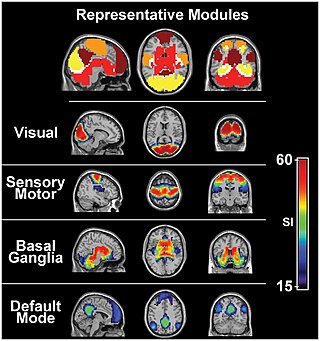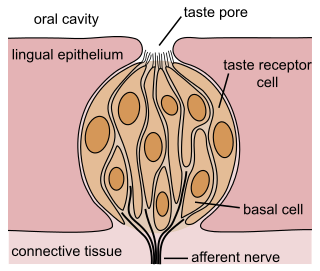Related Research Articles

A sugar substitute is a food additive that provides a sweetness like that of sugar while containing significantly less food energy than sugar-based sweeteners, making it a zero-calorie or low-calorie sweetener. Artificial sweeteners may be derived through manufacturing of plant extracts or processed by chemical synthesis. Sugar substitute products are commercially available in various forms, such as small pills, powders, and packets.

Umami, or savoriness, is one of the five basic tastes. It has been described as savory and is characteristic of broths and cooked meats.

Acesulfame potassium, also known as acesulfame K or Ace K, is a synthetic calorie-free sugar substitute often marketed under the trade names Sunett and Sweet One. In the European Union, it is known under the E number E950. It was discovered accidentally in 1967 by German chemist Karl Clauss at Hoechst AG. In chemical structure, acesulfame potassium is the potassium salt of 6-methyl-1,2,3-oxathiazine-4(3H)-one 2,2-dioxide. It is a white crystalline powder with molecular formula C
4H
4KNO
4S and a molecular weight of 201.24 g/mol.

The sensory nervous system is a part of the nervous system responsible for processing sensory information. A sensory system consists of sensory neurons, neural pathways, and parts of the brain involved in sensory perception and interoception. Commonly recognized sensory systems are those for vision, hearing, touch, taste, smell, balance and visceral sensation. Sense organs are transducers that convert data from the outer physical world to the realm of the mind where people interpret the information, creating their perception of the world around them.
In physiology, transduction is the translation of arriving stimulus into an action potential by a sensory receptor. It begins when stimulus changes the membrane potential of a receptor cell.

Diet or light beverages are generally sugar-free, artificially sweetened beverages with few or no calories. They are marketed for diabetics and other people who want to reduce their sugar and/or caloric intake.

Sensory neurons, also known as afferent neurons, are neurons in the nervous system, that convert a specific type of stimulus, via their receptors, into action potentials or graded receptor potentials. This process is called sensory transduction. The cell bodies of the sensory neurons are located in the dorsal ganglia of the spinal cord.

Lactisole is the sodium salt and commonly supplied form of 2-(4-methoxyphenoxy)propionic acid, a natural carboxylic acid found in roasted coffee beans. Like gymnemic acid, it has the property of masking sweet flavors and is used for this purpose in the food industry.

Sweetness is a basic taste most commonly perceived when eating foods rich in sugars. Sweet tastes are generally regarded as pleasurable. In addition to sugars like sucrose, many other chemical compounds are sweet, including aldehydes, ketones, and sugar alcohols. Some are sweet at very low concentrations, allowing their use as non-caloric sugar substitutes. Such non-sugar sweeteners include saccharin and aspartame. Other compounds, such as miraculin, may alter perception of sweetness itself.
In medicine and anatomy, the special senses are the senses that have specialized organs devoted to them:
Fruit2O, formerly manufactured by Kraft, is a lightly flavored, non-carbonated water beverage introduced in 1999. Fruit2o was introduced to compete not only with the bottled water market but also with the soft drink market. Sunny Delight Beverages purchased the Veryfine Products line from Kraft in 2007.
Chemesthesis is the chemical sensitivity of the skin and mucous membranes. Chemesthetic sensations arise when chemical compounds activate receptors associated with other senses that mediate pain, touch, and thermal perception. These chemical-induced reactions do not fit into the traditional sense categories of taste and smell.

A taste receptor or tastant is a type of cellular receptor which facilitates the sensation of taste. When food or other substances enter the mouth, molecules interact with saliva and are bound to taste receptors in the oral cavity and other locations. Molecules which give a sensation of taste are considered "sapid".

The use of wine tasting descriptors allows the taster to qualitatively relate the aromas and flavors that the taster experiences and can be used in assessing the overall quality of wine. Wine writers differentiate wine tasters from casual enthusiasts; tasters attempt to give an objective description of the wine's taste, casual enthusiasts appreciate wine but pause their examination sooner than tasters. The primary source of a person's ability to taste wine is derived from their olfactory senses. A taster's own personal experiences play a significant role in conceptualizing what they are tasting and attaching a description to that perception. The individual nature of tasting means that descriptors may be perceived differently among various tasters.

T1R2 - Taste receptor type 1 member 2 is a protein that in humans is encoded by the TAS1R2 gene.

Taste receptor, type 2, member 31, also known as TAS2R31, is a protein which in humans is encoded by the TAS2R31 gene. This bitter taste receptor has been shown to respond to saccharin in vitro.
The primary gustatory cortex (GC) is a brain structure responsible for the perception of taste. It consists of two substructures: the anterior insula on the insular lobe and the frontal operculum on the inferior frontal gyrus of the frontal lobe. Because of its composition the primary gustatory cortex is sometimes referred to in literature as the AI/FO(Anterior Insula/Frontal Operculum). By using extracellular unit recording techniques, scientists have elucidated that neurons in the AI/FO respond to sweetness, saltiness, bitterness, and sourness, and they code the intensity of the taste stimulus.

The gustatory system or sense of taste is the sensory system that is partially responsible for the perception of taste (flavor). Taste is the perception stimulated when a substance in the mouth reacts chemically with taste receptor cells located on taste buds in the oral cavity, mostly on the tongue. Taste, along with the sense of smell and trigeminal nerve stimulation, determines flavors of food and other substances. Humans have taste receptors on taste buds and other areas, including the upper surface of the tongue and the epiglottis. The gustatory cortex is responsible for the perception of taste.
A sense is a biological system used by an organism for sensation, the process of gathering information about the surroundings through the detection of stimuli. Although, in some cultures, five human senses were traditionally identified as such, many more are now recognized. Senses used by non-human organisms are even greater in variety and number. During sensation, sense organs collect various stimuli for transduction, meaning transformation into a form that can be understood by the brain. Sensation and perception are fundamental to nearly every aspect of an organism's cognition, behavior and thought.
Neurogastronomy is the study of flavor perception and the ways it affects cognition and memory. This interdisciplinary field is influenced by the psychology and neuroscience of sensation, learning, satiety, and decision making. Areas of interest include how olfaction contributes to flavor, food addiction and obesity, taste preferences, and the linguistics of communicating and identifying flavor. The term neurogastronomy was coined by neuroscientist Gordon M. Shepherd.
References
- 1 2 3 4 Neely, Greg; Borg, Gunnar (1999). "The Perceived Intensity of Caffeine Aftertaste: Tasters Versus Nontasters". Chemical Senses. 24 (1): 19–21. doi: 10.1093/chemse/24.1.19 . PMID 10192472.
- 1 2 James, G. A.; Li, X.; DuBois, G. E.; Zhou, L.; Hu, X. P. (2009). "Prolonged insula activation during perception of aftertaste". NeuroReport. 20 (3): 245–250. doi:10.1097/WNR.0b013e32831d2441. PMID 19444946. S2CID 22846384.
- 1 2 Just, T.; Pau, H. W.; Engel, U.; Hummel, T. (2008). "Cephalic phase insulin release in healthy humans after taste stimulation?". Appetite. 51 (3): 622–627. doi:10.1016/j.appet.2008.04.271. PMID 18556090. S2CID 11623863.
- ↑ Valentová, H.; Skrovánková, S.; Panovská, Z.; Pokorný, J. (2002). "Time–intensity studies of astringent taste". Food Chemistry. 78 (1): 29–37. doi:10.1016/S0308-8146(01)00330-2.
- ↑ DuBois, G. E.; Lee, J. F. (1983). "A simple technique for the evaluation of temporal taste properties". Chemical Senses. 7 (3–4): 237–247. doi:10.1093/chemse/7.3-4.237.
- ↑ Duffy, V. B.; Davidson, A. C.; Kidd, J. R.; Kidd, K. K.; Speed, W. C.; Pakstis, A. J.; Reed, D. R.; Snyder, D. J.; Bartoshuk, L. M. (2004). "Bitter Receptor Gene (TAS2R38), 6-n-Propylthiouracil (PROP) Bitterness and Alcohol Intake". Alcoholism: Clinical & Experimental Research. 28 (11): 1629–1637. doi:10.1097/01.ALC.0000145789.55183.D4. PMC 1397913 . PMID 15547448.
- 1 2 Reed, D. R.; Tanaka, T.; McDaniel, A. H. (2006). "Diverse tastes: Genetics of sweet and bitter perception". Physiology & Behavior. 88 (3): 215–226. doi:10.1016/j.physbeh.2006.05.033. PMC 1698869 . PMID 16782140.
- 1 2 Peri, I.; Mamrud-Brains, H.; Rodin, S.; Krizhanovsky, V.; Shai, Y.; Nir, S.; Naim, M. (2000). "Rapid entry of bitter and sweet tastants into liposomes and taste cells: implications for signal transduction". American Journal of Physiology. Cell Physiology. 278 (1): C17–25. doi:10.1152/ajpcell.2000.278.1.c17. PMID 10644507. S2CID 3024764.
- ↑ Naim M, Nir S, Spielman AI, Noble AC, Peri I, et al. Hypothesis of receptordependent and receptor-independent mechanisms for bitter and sweet taste transduction: implications for slow taste onset and lingering aftertaste. In: Given P, Parades D, editors. Chemistry of Taste: Mechanisms, Behaviors, and Mimics ACS Symposium Series. Vol. 825. Washington, DC: Am. Chem. Soc; 2002. pp. 2–17.
- ↑ Shepherd, G. M. (2006). "Smell images and the flavour system in the human brain". Nature. 444 (7117): 316–321. Bibcode:2006Natur.444..316S. doi:10.1038/nature05405. PMID 17108956. S2CID 4325645.
- 1 2 Stevenson, R.J. (2009). The psychology of flavour. Oxford: Oxford University Press.
- ↑ Small, D. M.; Prescott, J. (2005). "Odor/taste integration and the perception of flavor". Experimental Brain Research. 166 (3–4): 345–357. doi:10.1007/s00221-005-2376-9. PMID 16028032. S2CID 403254.
- ↑ Verhagen, J. V.; Engelen, L. (2006). "The neurocognitive bases of human multimodal food perception: Sensory integration". Neuroscience & Biobehavioral Reviews. 30 (5): 613–650. doi:10.1016/j.neubiorev.2005.11.003. PMID 16457886. S2CID 22560560.
- ↑ Kuhn, C.; Bufe, B.; Winnig, M.; Hofmann, T.; Frank, O.; Behrens, M.; Lewtschenko, T.; Slack, J. P.; Ward, C. D.; Meyerhof, W. (2004). "Bitter Taste Receptors for Saccharin and Acesulfame K". Journal of Neuroscience. 24 (45): 10260–10265. doi:10.1523/JNEUROSCI.1225-04.2004. PMC 6730199 . PMID 15537898.
- ↑ Slack, J. P.; Brockhoff, A.; Batram, C.; Menzel, S.; Sonnabend, C.; Born, S.; Galindo, M. M.; Kohl, S.; Thalmann, S.; Ostopovici-Halip, L.; Simons, C. T.; Ungureanu, I.; Duineveld, K.; Bologa, C. G.; Behrens, M.; Furrer, S.; Oprea, T. I.; Meyerhof, W. (2010). "Modulation of Bitter Taste Perception by a Small Molecule hTAS2R Antagonist". Current Biology. 20 (12): 1104–1109. doi:10.1016/j.cub.2010.04.043. PMC 2925244 . PMID 20537538.
- 1 2 Stone, H, & L., J. (2004). Sensory evaluation practices. Amsterdam: Elsevier Academic Press.